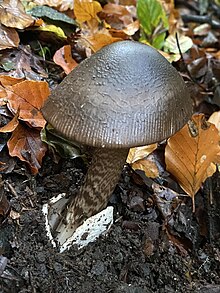| Amanita pekeoides | |
|---|---|

| |
| Amanita pekeoides in Chingford Park, Dunedin, New Zealand | |
| Scientific classification | |
| Domain: | Eukaryota |
| Kingdom: | Fungi |
| Division: | Basidiomycota |
| Class: | Agaricomycetes |
| Order: | Agaricales |
| Family: | Amanitaceae |
| Genus: | Amanita |
| Species: | A. pekeoides
|
| Binomial name | |
| Amanita pekeoides G.S.Ridl. (1991)
| |
Amanita pekeoides is a species of fungus in the family Amanitaceae. It is endemic to New Zealand.[1]
Taxonomy[edit]
The species was first described scientifically by New Zealand mycologist Geoff Ridley in 1991.[2]
The holotype specimen was collected at Paua Ridge, Orongorongo Valley, Rimutaka Forest Park, Wellington, New Zealand.[2]
The specific epithet pekeoides derives from the Māori word peke meaning sack or bag, in reference to the saccate volva from which the fruiting body emerges.[2]
Description[edit]
Ridley described Amanita pekeoides as a “typical member of the Vaginatae” due to the “non-bulbous stipe, saccate volva, and inamyloid basidiospores”.[2]
The pileus of A. pekeoides is described as being between 32–82 millimetres (1+1⁄2–3 inches) and convex in shape when immature, gradually becoming plano-convex then plano-depressed as the fruiting body matures.[2] The margin of the pileus is sulcate, with the grooves being greyish sepia while the disc and ridges are hazel to dark greyish sepia, paling at the margin.[2] The pileus is viscid when wet but dries quickly.[2] The lamellae are crowded but free; usually 6–10 mm wide, pale buff to buff with a complete margin that is brown vinaceous to dark grey sepia, and truncated lamellulae.[2] The stipe is typically 7–12 centimetres (3–4+1⁄2 in) high, 7–10 mm in diameter, hollow, tapering apically, and the surface is white to pale greyish sepia, with hazel to greyish sepia striate bands, which become finer and more numerous towards the apex.[2] A notable distinction of A. pekeoides from many other Amanita species is its lack of annulus.[2] A. pekeoides exhibits a whitish to pale sepia or pale brown vinaceous, 30–58 mm volva which is often hidden under substrate.[2] The volva starts out fleshy but becomes membranous with age, is saccate and usually bilabiate.[2]
Some Amanita pekeoides found only in the Nelson region of the South Island and Te Urewera National park in the North Island have a distinctly friable volva which leaves remnants on the pileus and stipe.[2] It is yet to be determined whether this characteristic represents a different population entirely or simply indicates a lack of collection from other areas.[2] There are also some individuals which appear to be more whitish in colour but are otherwise identical to other Amanita pekeoides.[2]
Distribution and habitat[edit]
A. pekeoides occurs in the North and South Islands of New Zealand, and is primarily associated with Nothofagus species.[1][2]
See also[edit]
References[edit]
- ^ a b "VIRTUAL MYCOTA: NZ Fungi Identification: Amanita pekeoides". virtualmycota.landcareresearch.co.nz. Retrieved 2023-05-31.
- ^ a b c d e f g h i j k l m n o p Ridley, G.S. (1991). "The New Zealand species of Amanita (Fungi: Agaricales)". Australian Systematic Botany. 4 (2): 325–354. doi:10.1071/sb9910325.
